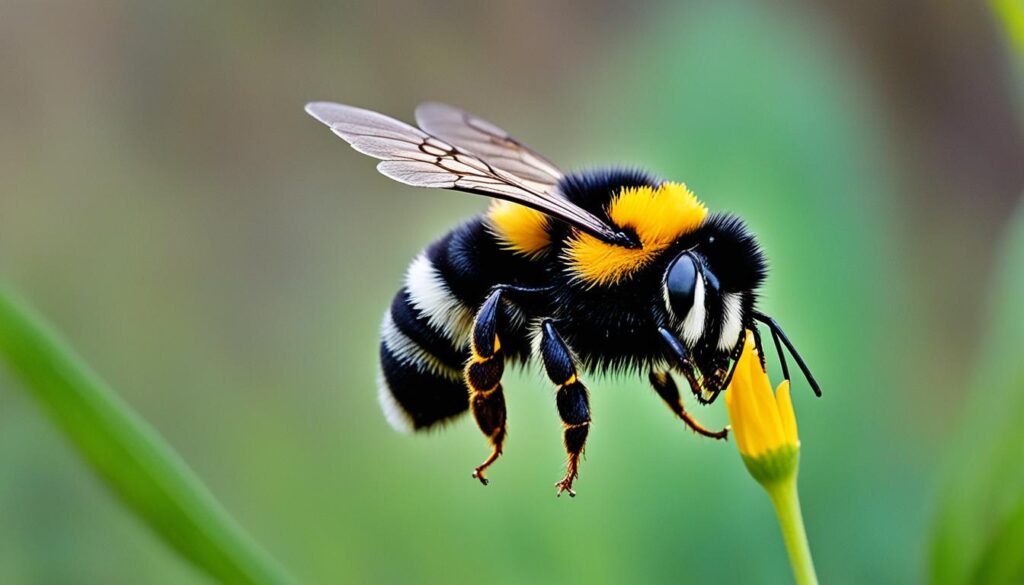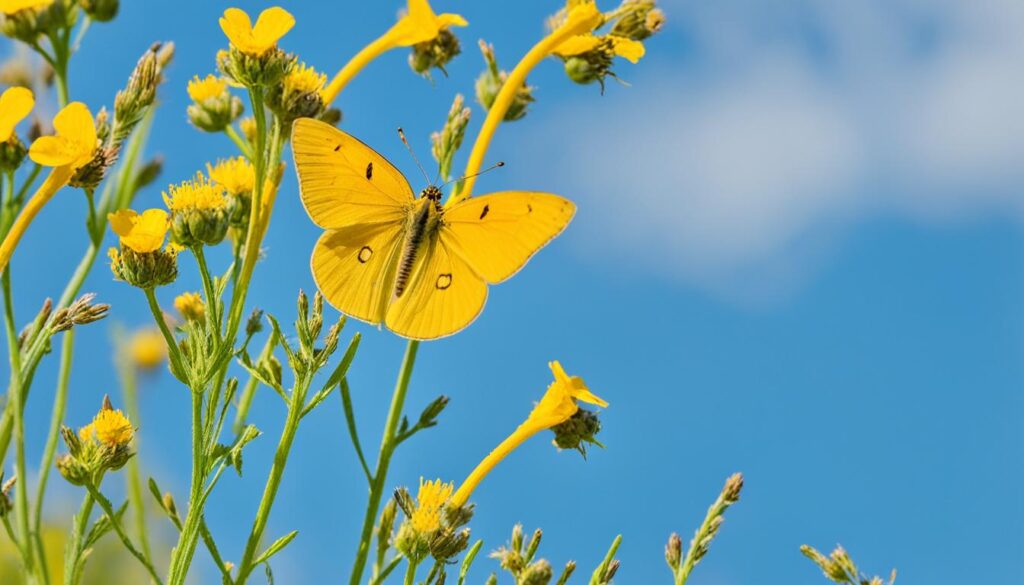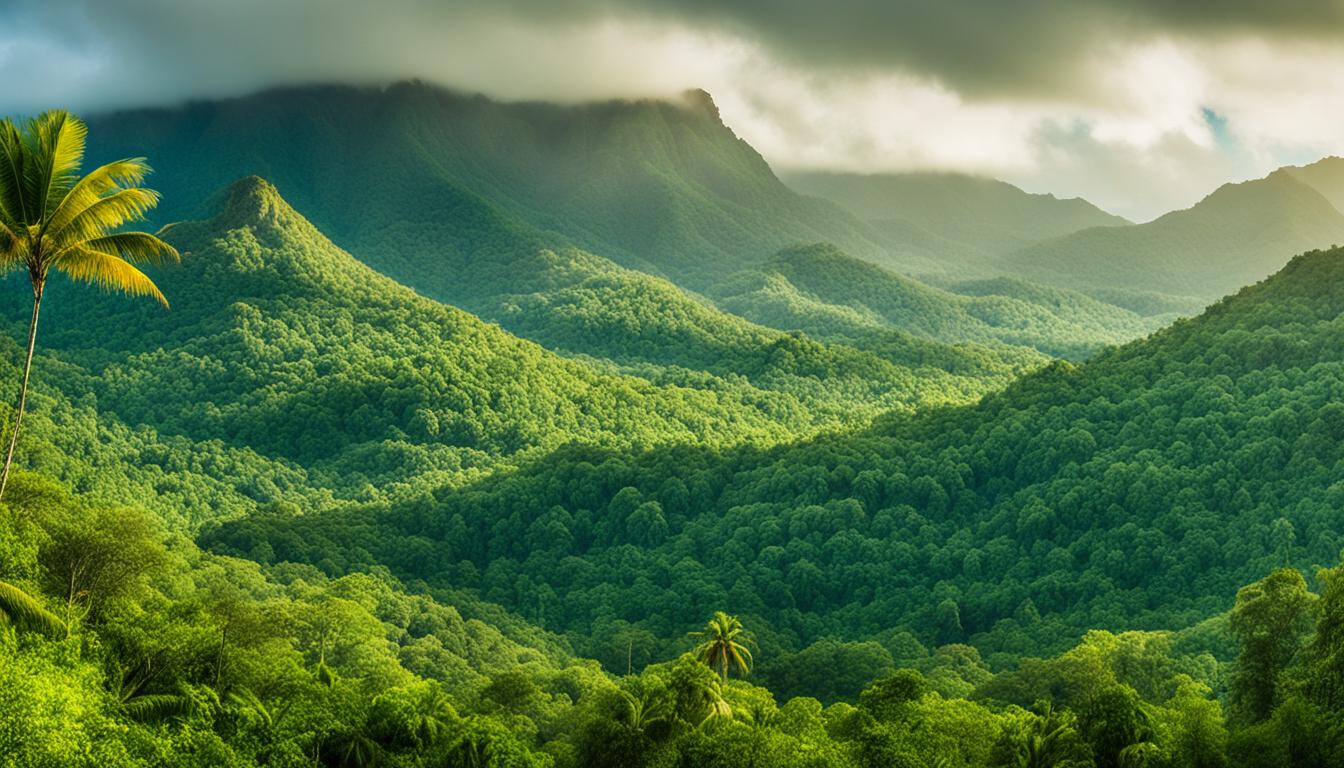Have you ever thought about how unique and fascinating yellow animals are in the wild? Though yellow isn’t a common color in the animal kingdom, there are various gorgeous species that display this lively shade. From birds to reptiles and insects, these yellow animals truly highlight the splendor of nature’s colors. Join me as we delve into the world of these sun-kissed marvels in their native environments. Discover the stunning beauty and diversity that yellow animals bring to our ecosystem.
Key Takeaways:
- Yellow animals are a rare and captivating sight in the natural world.
- Several stunning species showcase vibrant yellow hues.
- From birds to reptiles and insects, these animals add color to nature’s palette.
- Exploring their natural habitats reveals the beauty of these sun-kissed wonders.
- Yellow animals are a testament to the rich biodiversity of our planet.
American Yellow Warbler
The American Yellow Warbler, scientifically known as Setophaga petechia, is a small bird that can be found across most of North America and northern South America. These birds measure about 4″-7″ long and primarily feed on caterpillars, invertebrates, and small pieces of fruit.
The males of the American Yellow Warbler are particularly vibrant, especially during their breeding season when they display their distinctive lemon yellow plumage. The intensity of the yellow coloration can vary across subspecies, but it always adds a pop of brightness to the surroundings.
In addition to their visual appeal, American Yellow Warblers play a crucial role in controlling insect populations. They have a voracious appetite for insects, making them beneficial to farmers and gardeners. By reducing the number of pests, these birds contribute to maintaining a healthy ecosystem.
With their cheerful colors and melodious songs, American Yellow Warblers are a delight to observe and listen to in their natural habitats. Their presence adds a touch of vibrancy and beauty to the North American landscape, reminding us of the wonders of the avian world.
Breeding Plumage Variation
The breeding plumage of the American Yellow Warbler can be further appreciated by examining the variations across different subspecies. The extent and intensity of yellow coloration can vary, with some subspecies having a more vibrant hue than others.
| Subspecies | Yellow Plumage Description |
|---|---|
| S.p. aestiva | Lemon yellow coloration with a slight green tinge on the back and wings. Distinctive red streaks may be present on the breast. |
| S.p. rufopileata | Bright yellow plumage with a reddish-brown cap and streaks on the breast. |
| S.p. morcomi | Pale lemon yellow coloration with a greenish tinge and limited dark streaking. |
These variations in breeding plumage add to the unique charm and diversity of the American Yellow Warbler population, highlighting the beauty of nature’s creations.
Fire Salamander
The Fire Salamander, scientifically known as Salamandra salamandra, is a striking amphibian that inhabits forested areas of central Europe. These salamanders can grow up to 6″-10″ long and primarily feed on insects, slugs, spiders, and occasionally smaller frogs and newts. Their black bodies are adorned with yellow spots or stripes, some even displaying hints of orange or red. The vibrant coloring serves as a warning to potential predators, as they secrete a toxic alkaloid. Interestingly, the Fire Salamander is known for its long lifespan, with one individual living over 50 years in a German natural history museum.

| Scientific Name | Habitat | Size | Diet | Coloration |
|---|---|---|---|---|
| Salamandra salamandra | Forested areas of central Europe | 6″-10″ long | Insects, slugs, spiders, smaller frogs and newts | Black with yellow spots or stripes, some hints of orange or red |
Yellow Boxfish
The Yellow Boxfish, scientifically known as Ostracion cubicum, is a stunning fish found in coral reefs across the Pacific Ocean, Indian Ocean, and southeastern Atlantic Ocean. Growing up to 18″ long, this fish primarily feeds on marine algae but also consumes aquatic animals. The young boxfish are bright yellow with dark spots, while older individuals eventually fade to gray-brown with touches of yellow. Despite their boxy body shape, these fish have a unique style of swimming that allows them to navigate their surroundings with agility. In fact, Mercedes-Benz even released a car concept inspired by the boxfish’s shape, although it was later discovered that the fish’s swimming ability is not due to its body shape.

Yellow Boxfish Key Features
- Scientific Name: Ostracion cubicum
- Size: Up to 18″ long
- Primary Diet: Marine algae
- Coloration: Bright yellow with dark spots (young) to gray-brown with touches of yellow (adult)
- Habitat: Coral reefs in the Pacific Ocean, Indian Ocean, and southeastern Atlantic Ocean
Unique Swimming Style
One of the most fascinating aspects of the Yellow Boxfish is its unique swimming style. Despite its boxy body shape, the fish is incredibly agile in the water. It uses fluttering movements of its pectoral fins to maneuver through coral reefs and navigate its surroundings. This swimming style allows the Yellow Boxfish to gracefully glide through the water and explore its colorful habitat.
“The Yellow Boxfish demonstrates that nature’s designs can inspire not only art and architecture but also automotive innovation.” – marine biologist Dr. Anna Williams
Buff-Tailed Bumblebee
The Buff-Tailed Bumblebee, scientifically known as Bombus terrestris, is one of the most common bumblebee species in Europe. These small insects, measuring about 0.4″-0.7″ long, have bodies marked with black and yellow bands, with soft buff-white tails. Like other bee species, buff-tailed bumblebees have a complex social structure including a queen, worker bees, and drones. They play a crucial role in pollination and contribute to maintaining the balance of ecosystems.

The Buff-Tailed Bumblebee is an essential pollinator in European ecosystems. Its black and yellow banding, along with its soft buff-white tail, distinguishes it from other bee species. With a complex social structure, including queens, workers, and drones, this bumblebee species works together to ensure the survival and reproduction of their colony. A truly remarkable insect, the Buff-Tailed Bumblebee helps maintain the biodiversity and ecological balance of Europe.
Comparison of Bumblebee Species in Europe
| Bumblebee Species | Average Length (inches) | Coloration | Social Structure |
|---|---|---|---|
| Buff-Tailed Bumblebee (Bombus terrestris) | 0.4″-0.7″ | Black and yellow bands with buff-white tail | Queen, workers, and drones |
| Garden Bumblebee (Bombus hortorum) | 0.5″-0.8″ | Black and yellow bands with white tail | Queen, workers, and drones |
| Red-Tailed Bumblebee (Bombus lapidarius) | 0.6″-0.9″ | Black body with red tail | Queen, workers, and drones |
Western Tanager
The Western Tanager, scientifically known as Piranga ludoviciana, is a colorful bird predominantly found in wooded areas of western North America. These birds measure about 6.3″-7.5″ long and have a diet consisting of fruit and various insects. The male Western Tanager stands out with its bright sunny yellow body and bright red head, contrasting with its black wings and tail. Interestingly, taxonomic research has led to the Western Tanager being reclassified from the tanager family to the cardinal family, indicating their closer relation to cardinals and similar birds.
These elegant birds are known for their vibrant plumage, attracting birdwatchers and nature enthusiasts. They are commonly found in coniferous forests, open woodlands, and mountainous regions throughout their range. The Western Tanager’s yellow coloration serves as a signal to both potential mates and rivals, as it signifies their vitality and reproductive fitness.
In addition to their striking appearance, Western Tanagers are renowned for their melodious songs and cheerful calls, adding a delightful soundtrack to their natural habitat. They have a wide vocal range and their songs vary depending on the season and context.

The Western Tanager’s coloration change during its lifecycle is truly remarkable. Juveniles and females have a more muted appearance, with an olive-yellow body and greyish head. However, as the males mature, they undergo a stunning transformation, showcasing their vibrant yellow and red plumage. This coloration change is an evolutionary adaptation that helps the males attract mates and defend their territories.
The Western Tanager’s habitat spans from the western coast of North America, including parts of Canada, down to Mexico, where they spend the winter. They are known for their long-distance migrations, traveling thousands of miles each year to breed and overwinter in different regions.
Western Tanager Population and Conservation
The population of Western Tanagers is considered stable, although certain factors, such as habitat loss due to deforestation and climate change, can pose threats to their long-term survival. It is crucial to protect and preserve their natural habitat to ensure the continued presence of these stunning birds.
Conservation efforts should focus on maintaining healthy forests, promoting sustainable forestry practices, and raising awareness about the importance of preserving ecosystems for the Western Tanager and other wildlife species.
| Common Name | Scientific Name | Length | Diet | Coloration |
|---|---|---|---|---|
| Western Tanager | Piranga ludoviciana | 6.3″-7.5″ (16-19 cm) | Fruit, insects | Yellow body, red head, black wings and tail |
By appreciating and protecting the Western Tanager and its habitat, we can contribute to the preservation of this stunning bird species and the biodiversity of western North America.
Albino Burmese Python
The Albino Burmese Python, scientifically known as Python molurus bivittatus, is a snake native to areas near water in South Asia and Southeast Asia. These impressive snakes can reach lengths of up to 16′ and weigh over 400 pounds. While their wild-type counterparts are typically dark in color, albino individuals exhibit a striking pattern of yellow and white.
“The Albino Burmese Python is truly a mesmerizing creature with its vibrant yellow and white markings. Its large size and unique coloration make it a captivating sight in the snake world.” – Reptile Enthusiast Magazine
It is worth noting that Burmese pythons have become an invasive species in Florida after escaping from a breeding facility during a hurricane in 1992. They are known to prey on mammals, birds, reptiles, and amphibians, posing a significant threat to the local ecosystem.

The Albino Burmese Python’s adaptability and predatory nature make it a formidable presence in its new environment. Efforts are being made to manage and control the population of these invasive pythons in Florida to prevent further ecological damage.
Axolotl
The Axolotl, scientifically known as Ambystoma mexicanum, is an aquatic salamander found in freshwater lakes in Mexico. These salamanders can reach lengths of about 6″-18″ and primarily consume various small aquatic animals. While wild axolotls are frequently dark in color, captive-bred individuals have been bred in a variety of colors, including shades close to the color of a lemon peel.
Unfortunately, due to habitat destruction, water pollution, and predation by invasive fish species, axolotls are currently classified as critically endangered in the wild. However, their popularity as pets and their use in scientific research may contribute to their preservation.

Apricot Sulphur
The Apricot Sulphur, scientifically known as Phoebis argante, is a butterfly species found in various habitats from Mexico to Peru, Cuba, and the Antilles. With a wingspan of about 2.1″-2.6″, the undersides of these butterflies’ wings are bright yellow with a few tan markings, while the dorsal side displays a color between yellow and orange, resembling the color of an apricot. Notably, only male Apricot Sulphur butterflies have this distinct coloration, with females appearing very pale yellow or white. They are often seen around mud puddles, where they obtain vitamins and minerals from the soil.

| Common Name | Scientific Name | Habitat | Wingspan | Coloration |
|---|---|---|---|---|
| Apricot Sulphur | Phoebis argante | Mexico, Peru, Cuba, Antilles | 2.1″-2.6″ | Bright yellow with tan markings on the undersides and apricot-like color on the dorsal side |
Oleander Aphid
The Oleander Aphid, scientifically known as Aphis nerii, is a tiny aphid species found in various tropical and Mediterranean climates around the world. These bugs have an extremely vivid yellow body, with dark brown or black legs. They often form large colonies on plants, creating a noticeable patch of yellow.
Interestingly, the oleander aphid has a unique reproductive method. Females give birth to live young from unfertilized egg cells, a phenomenon known as parthenogenesis. This means that males are not necessary for reproduction, and male oleander aphids have never been observed in the wild. However, under certain laboratory conditions, male oleander aphids can be produced.

Climbing Mantella
The Climbing Mantella, scientifically known as Mantella laevigata, is a small frog species found in tropical and subtropical forests in Madagascar. These frogs measure about 0.86″-1.14″ long and primarily feed on ants. They have a striking coloration, with a black base color and small irregular blue spots on the legs and belly. The tops of their heads and backs are bright sunny yellow.
Currently, the Climbing Mantella is not classified as being at risk of extinction, but habitat loss and collection for the pet trade pose threats to their population.

| Species | Scientific Name | Size | Diet | Coloration |
|---|---|---|---|---|
| Climbing Mantella | Mantella laevigata | 0.86″-1.14″ | Ants | Black with blue spots and bright yellow |
Conclusion
The natural world is a treasure trove of vibrant hues, and yellow animals play a vital role in adding a burst of beauty to our surroundings. From the American Yellow Warbler with its bright plumage to the mesmerizing patterns of the Albino Burmese Python, these stunning species captivate our imagination and showcase the extraordinary biodiversity that exists.
By appreciating and understanding these yellow animals, we gain a deeper appreciation for the wonders of the natural world. Each species brings a unique charm, marking their presence with vibrant yellow hues that blend seamlessly with their surroundings. These creatures are a testament to the incredible diversity found in the animal kingdom and remind us of the stunning colors that grace our planet.
As we explore the vivid world of yellow animals, we become more aware of the delicate balance of nature and the importance of preserving the biodiversity around us. The vibrant colors of these stunning species serve as a reminder of our responsibility to protect and conserve their habitats for future generations to admire and cherish.










